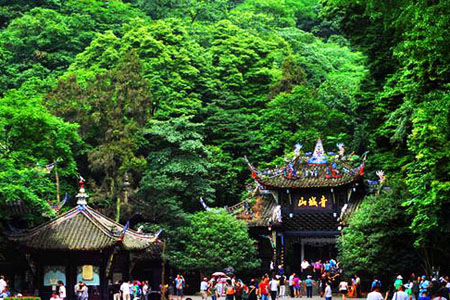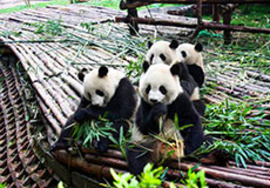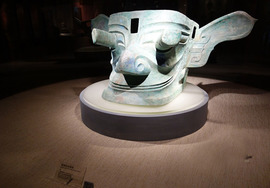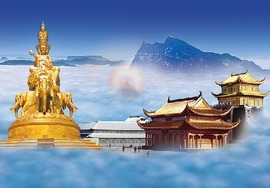The Leshan Giant Buddha is a statue of Maitreya (a Bodhisattva usually represented as a very stout monk with a broad smile on his face and with his naked breast and paunch exposed to view) in sitting posture. The Buddha is located to the east of Leshan City, Sichuan Province, at the confluence of three rivers, namely, Min River, Qingyi River, and Dadu River. The statue makes itself the most renowned scenic spot in Leshan City.
In December, 1996, the location of the Buddha was included by UNESCO on the list of the World Heritage sites. Begun in the year 713 in the Tang Dynasty, and finished in the year 803, the statue took people more than 90 years to carve. During these years, thousands of workers had expended their efforts and wisdom on the project. As the biggest carved stone Buddha in the world, Leshan Giant Buddha is featured in poetry, song and story.
Leshan Giant Buddha Scenic Spot is composed of Lingyun Mountain, Mahaoyan Tomb, Wuyou Mountain and Giant lying Buddha landscape, covering an area of about 8 square kilometers.
The Legend of Leshan Giant Buddha
Facing the river, the Buddha has symmetrical posture and looks which have been beautifully captured in its solemn stillness. It is 71 meters (about 233 feet) high, and has three-meter-long (about 11 feet) fingers. The eight-meter-long (about 27 feet) instep is big enough for one hundred people to sit on and the 28-meter-wide (about 92 feet) shoulder is large enough to be a basketball playground.
It was a monk called Hai Tong who initiated the project. His concern was for the safety of the long-suffering people who earned their living around the confluence of the three rivers. Tempestuous waters ensured that boat accidents were numerous and the simple people put the disaster down to the presence of a water spirit. So Hai Tong decided to carve a statue beside the river thinking that the Buddha would bring the water spirit under control.
Besides, the fallen stones dropped during the carving would reduce the water force there. After 20 years' begging alms, he finally accumulated enough money for the plan. When some local government officials had designs on tempting this amount of money, Hai Tong said that they could get his eyeball but not the money raised for the Buddha. After Hai Tong dug out his eyeball, these officials ran away scared. The project was half done when Hai Tong passed away, and two of his disciples continued the work. After a total of 90 years' hard work, the project was finally completed.
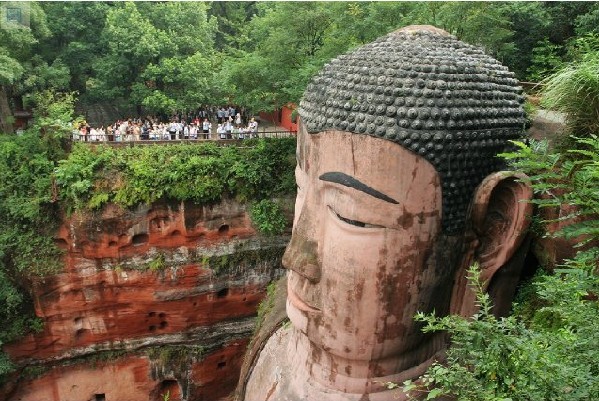 The charm of the Buddha lies not only in its size but also in its architectural artistry. There are 1,021 buns in the Buddha's coiled hair. These have been skillfully embedded in the head. The skill is so wonderful that the 1,021 buns seem integral to the whole.
The charm of the Buddha lies not only in its size but also in its architectural artistry. There are 1,021 buns in the Buddha's coiled hair. These have been skillfully embedded in the head. The skill is so wonderful that the 1,021 buns seem integral to the whole.
The Draginage System of Leshan Giant Buddha
Another architectural highlight is the drainage system. This system is made up of some hidden gutters and channels, scattered on the head and arms, behind the ears and in the clothes. This system, which helps displace rainwater and keep the inner part dry, plays an important part in the protection of the Buddha. The large pair of ears, each seven meters (about 23 feet) long, is made of wood and is decorated by mud on the surface. For craftsmen of thousands of years ago, it was not easy to fix these to the stone head.
Having such a long history and such worldwide fame, the renovation of the Buddha has received extensive attention both at home and abroad. The Buddha was nearly destroyed by the erosion of wind and rain before 1963 when the Chinese government began the repairing work. At present, the maintenance work is in progress under the instruction of experts from UNESCO.
The Attractions of Leshan Giant Buddha:
Leshan Giant Buddha
Leshan Giant Buddha is one of the finest arts in the Tang Dynasty, and is also the largest stone Maitreya Buddha in the world. The posture of the Buddha is touching his knees and sitting uprightly. The shape of the giant Buddha is solemn, and its drainage facilities are cleverly designed and hidden, indicating that it is not visible.
Along the left side of the Buddha, the ziazaging ridge plank road can directly reach the bottom of the Buddha. Looking up at the giant Buddha here, there will be a feeling of high elevation. Sitting like the right side of a nine-curved ancient plank road. The plank road along the right side of the Buddha in the cliff, extremely steep, twists and turns, to climb the top of the plank road. This is on the right side of the head of the Giant Buddha, which is on the top of Lingyun Mountain. Here, you can enjoy the carving art of the head of the giant Buddha. The hair on the top of the giant Buddha has 1,021 buns. From a distance, the bun and the head are integrated, but in fact, they are embedded one by one.
There is a closed hole in the chest, which is said to be a treasure cave. In fact, the cave is filled with waste iron, old lead skin, bricks and other construction waste.
Uyou temple
The Wuyou Temple is located on the top of the Wuyou Mountain, and was built in the Tang Dynasty. Wuyou Temple is a well-preserved temple in Sichuan Province and is one of the key temples in China. There are seven palaces of Wuyou Temple, all concentrated in the small Wuyou Mountain. By the mountain, the layout is clever, in China's temple garden architecture, there are a lot of bamboo and pvillions around the temple, scattered in the meantime, more particularly quiet. Tourists so far lotion mind, there is a feeling of detached from the world, began to believe in it is a different world.
Ma Hao cliff tomb
Ma hao cliff tomb is located in Lingyun, Wuyou two mountains between the east bank of the overflow river. Cliff tomb was popular in Leshan in the Han Dynasty, when they imitated the living residence, and then dig the tombs on the cliff. It was carved along the sandy rock formations of shallow hills and valleys, and then buried remains and funeral goods. From the outside, it is a deep and mysterious cave. This kind of tomb was popular in the Eastern Han Dynasty from the Northern to the Northern Dynasties, so it was called the Eastern Han Dynasty cliff tomb. Mahao ya tomb is the most concentrated and representative tomb group in Leshan. There are 544 cliff tombs about 200 meters long and 25 meters wide, and the tomb door is as dense as a beehive, which is very spectacular.
Lingyun Temple
Lingyun Temple is on the top of Lingyun Mountain of Leshan Giant Buddha, surrounded by nine peaks of Lingyun. Lingyun Temple main hall is brilliant. Because it is where the big Buddha is located, so it is also called the big Buddha temple. Lingyun Temple was founded in the Tang Dynasty, according to historical records, earlier before the Leshan Giant Buddha was dug, more than 1,200 years ago. Lingyun Temple is composed of the Temple of Heaven, the Hall of heaven, the Sutra building, with red walls and blue tiles and green trees. In front of the Tianwang Palace, ancient wood trees are towering, and the hall on both sides are monuments of Ming and Qing dynasties. In the middle of the hall is the statue of Jin Yu Maitreya, weighing 33 tons and carved from white marble. Through the Tianwang Palace, you will enter the Great Male Hall built in Qing Dynasty. In the middle of the hall are the three statues of Sakyamuni (past, now, future), with beautiful shapes and solemn manners. On both sides are the eighteen arhats, who have different god shapes, vividly.
Tour Map of Leshan Giant Buddha:
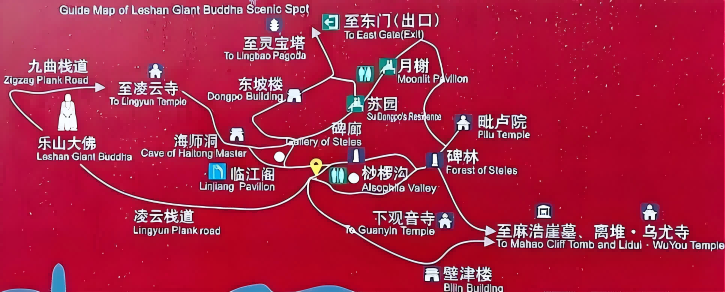
Weather Information of Leshan Giant Buddha:
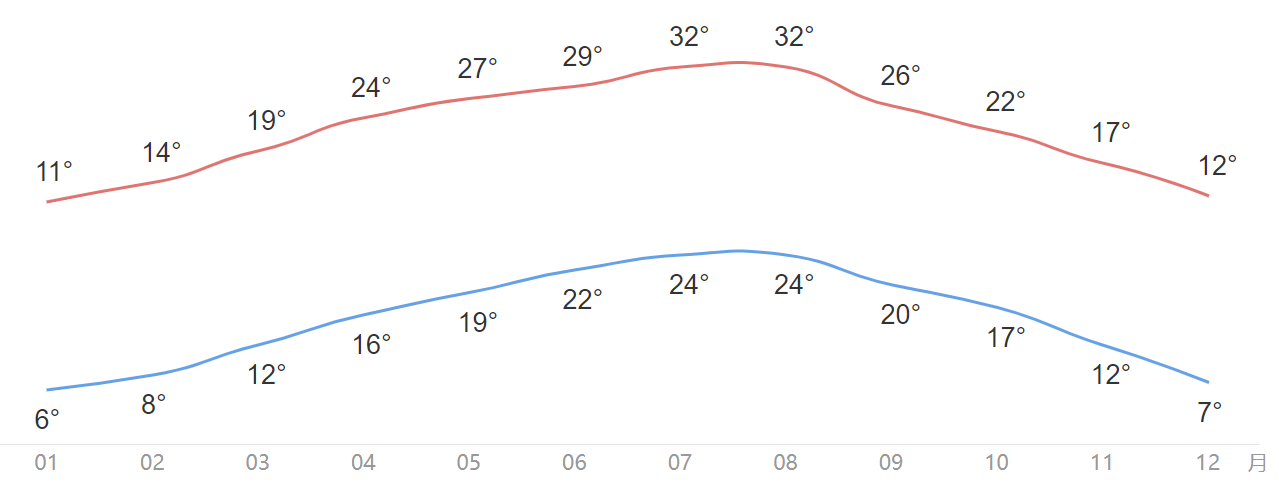
Note: From January to December, red line is the highest Centigrade in average, blue line is the lowest climate in average.
Recommended Leshan Giant Buddha Tour Packages:
1. 1 Day Chengdu Giant Panda and Leshan Buddha Day Trip
2. 1 Day Leshan Giant Buddha Bullet Train Tour
3. 2 Days for local Chengdu Tour with Panda and Leshan Giant Buddha
4. 2 Days Leshan Giant Buddha,Luocheng Ancient Town and Emei Mountain Tour from Chegndu
5. 2 Days for Jiayang Steam Train and Leshan Giant Buddha
6. 2 Days Bifengxia and Leshan Buddha Tour
7. 3 Days Chengdu Emeishan and Leshan Giant Buddha Tour
8. 3 Days’ Epicure Tours of Sichuan Food
9. 3 Days Culture Tour of Panda, Buddha, Paper and Tea in Sichuan
10. 8 Days Sichuan classical Tour
11. 8 Days Classic Tour of Jiuzhaigou,Leshan and Chengdu
12. Oriental Eden Exploration
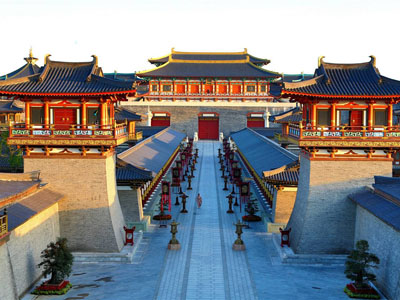
 The charm of the Buddha lies not only in its size but also in its architectural artistry. There are 1,021 buns in the Buddha's coiled hair. These have been skillfully embedded in the head. The skill is so wonderful that the 1,021 buns seem integral to the whole.
The charm of the Buddha lies not only in its size but also in its architectural artistry. There are 1,021 buns in the Buddha's coiled hair. These have been skillfully embedded in the head. The skill is so wonderful that the 1,021 buns seem integral to the whole.


